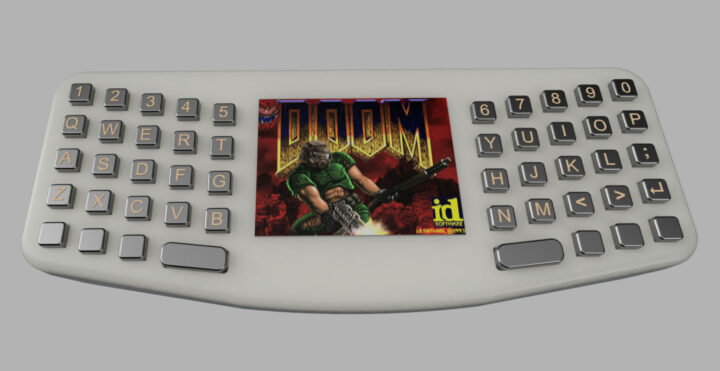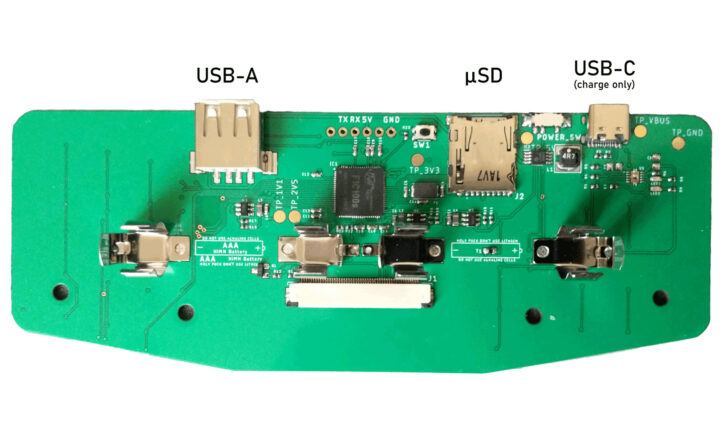Brian Benchoff’s “minimum viable computer'” is a Linux handheld computer powered by an Allwinner F1C100s ARM9 processor that could fit into your pocket and should cost about $15 (BoM cost) to manufacture in quantity.
The open-source hardware Linux “computer” comes with 32MB or 64MB RAM, a 2.3-inch color display, a 48-key keyboard, a USB port, and is powered by two AAA batteries. Don’t expect a desktop environment, but it can run a terminal to execute scripts, or even run Doom.
Minimum viable computer specifications:
- SoC – Allwinner F1C100s ARM926EJ-S CPU @ 533 MHz with 32 MB DDR built-in (Upgradable to 64 MB with the pin-compatible F1C200s)
- Storage – 64GB MicroSD card
- Display – 2.3” IPS TFT display with 320 x 240 resolution (ILI9342 SPI controller)
- USB – USB 2.0 Type-A port
- Keyboard – 48-key keyboard with a silicone membrane (just like most TV remote controls)
- Misc – Power button, 6-pin header with UART, 5V, GND
- Power Supply
- 2x AAA NiMH battery holders
- Charging over USB Type-C port @ 500mA
- Dimensions – TBD
All the hardware and software will be open-source with permissive licenses, as much as possible. Some new drivers had to be written for the board, and the code will also be released. Parts have been selected in a way so that they can be easily sourced and available, even in 2021/2022. You’ll note there’s no networking connectivity so you’d need to add a WiFi or Ethernet USB dongle if that’s important to you.
Brian says it cost $10,000 to build one, I suppose including the engineering costs and/or moulding costs as well, but calculated a BoM cost of about $15 when ordering 10,000 pieces with for instance the Allwinner F1C100s going for 75 cents, the display for $2.2, the 64GB MicroSD card for $2.2, the PCB for $2, the enclosure for $1.7, the keyboard for $1.2, the four battery connectors for $1.1, the two batteries for $1.1, with all the remaining components under $1.
The design is still in progress, and there will be other iterations of the hardware possibly with a slightly different set of features. You can find more details on the project’s page. Brian plans to eventually mass-produce the device, so a crowdfunding campaign may happen later this year. Note it’s not the first time we’ve seen Allwinner F1C100s processor in ultra-cheap “computer”, an example being a $3 Linux business card by George Hilliard.
Via Liliputing and Hacker News

Jean-Luc started CNX Software in 2010 as a part-time endeavor, before quitting his job as a software engineering manager, and starting to write daily news, and reviews full time later in 2011.
Support CNX Software! Donate via cryptocurrencies, become a Patron on Patreon, or purchase goods on Amazon or Aliexpress. We also use affiliate links in articles to earn commissions if you make a purchase after clicking on those links.






>Brian says it cost $10,000 to build one
I was going to say “hah, this guy is crazy” .. but I think I’ve spent around that on my QFN one chip Linux for everyone hobby.
Wacky components are cheap until you’re ordering $500+ partial trays to get your hands on one or two parts to mess around with.
That’s probably the point where you should realize that this might get a little out of hands.
Usually, you have to multiply the factory price by 4 until it gets to the customer.
Which would make this a $60 device, which seems resonable.
The 4X is for retail stores. If this is sold direct online you just need to add shipping, packaging, labor to ship and run website, tax, profit. You can do that for less than 2X BOM. look at rasp pi.
$60 a reasonable price? no way. I think we are losing track of the value of things due to the constant artificial increase in prices and COVID burlesque. If I could buy a decent SBC for $15 in 2016 means I can still buy a SBC in 2022 for $18, end of story.
Lots of cheap game emulation handhelds use this and other chips plus bigger displays.
Somebody should work with handheld maker for this type of board. After all the handheld makers, already order parts in bulk.
Would cost more, but could you build one from a Lichee Pi Zero ?
“easily sourced and available, even in 2021″
I’ll just pop back to 2021 in my Tardis and check!
So it’s a cheaper, and not industrial certified, alternative for ATSAMA5. Interesting for a cheap gateway or don’t sort.
Please, not another ARM11 core, please!
No worries it’s not ARM11, just ARM9 🙂
Oh, I feel *much* better. 😉 Sorry for the brain-o.
When I first glanced at the story I thought it said ARMv9. :O
Since when F1Cx00s exceeds 400MHz?
Disconnecting the memory controller clock allows speeds around 700 MHz easily.
Most people get them to 800MHz
But beginning around 500-600MHz they become usable for many handheld emulations from the 90s
Could you tell me where can I find more info about pulling this feat off?
More likely x2 @$30.
<plug>I know what I am talking about, we sold more than10k of our Allwinner V3s-based (Cortex A7 @1.2GHz) retro gaming console, all Open Source / Open Hardware:
https://www.funkey-project.com/
</plug>
Could you share your wisdom and experience with the world? It’s great that FKS is open-source, but it would be better if there was someone who after selling this many units could tell do’s and don’ts of the process of turning hackaday.io project into a product this well executed.
Good idea! But I really don’t know what would be the best channel to do so, do you have any suggestion?
Start by putting it pretty much anywhere; the most important thing is to get them down before they are forgotten. Perhaps build up over time as an article or series of articles on the funkey wiki or the Documentation page?
Once the notes are in final form, you might try adding as sort of a “closer” log to the original hacakday.io page? Maybe submit to hackaday as an article?
Like it!!
Personally I would OEM the keyboard, it don’t think it is good use of resources to build one. You can get wireless mouse/keyboard bundle for $3.90 in Q10000
https://www.alibaba.com/product-detail/Cheapest-2-4G-wireless-optical-USB_62107473840.html
OEM keyboard will cut mold costs in half. You can easily include different regional keyboard layouts. It is going to be very dealing with international keyboards on your own. Saving $5,000 on mold costs will buy 1,200 keyboards.
use the keyboard you already designed…..
https://bbenchoff.github.io/pages/keyboard.html
The AA battery holders are way over estimated
https://detail.1688.com/offer/623726653115.html
https://detail.1688.com/offer/615091533726.html
More like $0.10 for four, not $1.10
TPS613222A is half the cost of MCP1642B
I don’t think $2.20 is realistic for the display. Likely closer to $4-5.
You do realize he sourced it, right? That (2.2) is the price at quantity, and we know they are shipping because he got one himself…
Sure you can get surplus screens for $2.20. That is just not the market price of new IPS production. The chip shortage has caused a huge price spike in new LCD screens.
Now we just need to convince Benchoff to make the things… I would buy a parts kit, but I think he could cut some costs, such as not having the battery connectors (about $1 of the BOM). I would make my own connectors anyway, seeing as it would be pretty easy to stick a couple extra in there. There’s absolutely no reason why this shouldn’t have battery life up the wazoo.
He needs to make a kickstarter… I need 3 of them haha
i think a OS like https://kolibrios.org/en/ but made for this chip set would be pretty damn sweet since it wouln’t really over power it at all especially if he opted to bump up the cost and use the f1c200s.